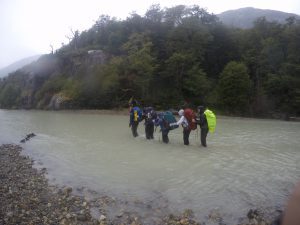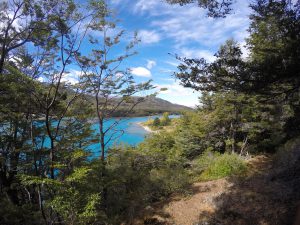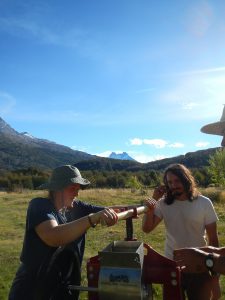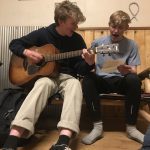HMI Gap: A Truly Wild Experience in Northern Patagonia’s Ice Fields
After a week of cultural immersion projects in Chile Chico everyone was eager to sleep under the stars once again. Part of our excitement came from knowing that on this expedition we would partner with Patagonia Frontiers to explore the Northern Patagonian Ice Field and contribute to their study on glacial recession in the area. Our team met Kelly and Felix, our guest instructors, in Puerto Bertrand. From there we combined boat shuttles and a hike to reach our first campsite on the bank of Lago Plomo. It felt amazing to be back out in our element!
 With the new course area came new terrain challenges: we endured lots of thorny bushwhacking and frequent fence hopping. It helped that while we made our way through the dense vegetation we were able to keep our destination, Patagonia Frontiers Ranch, in mind. Over ridges and through rivers we would intermittently stop for glaciology lessons presented by Felix. We eventually reached the ranch on a beautiful sunny day where we met the rest of the Ranch staff. The following morning we embarked on an ambitious hike 2,500 feet up to Valley One. The legendary Patagonian weather we had all been anxiously anticipating joined us halfway through the day. In the cool rain, we marched upwards. Nearing the campsite, we coined the term “alpine surfing” to describe that day’s terrain. We arrived safely, in high spirits, despite the challenging day we’d had. We were humbled by this new side of Patagonia. The next morning, as we hiked back to spend a few more nights at the ranch, we were greeted by the sunshine and the incredible views we’d missed on the way up. At the Ranch, we took day hikes, practiced research skills, and dried out our gear. Rejuvenated from our stay, we headed out to “Cacho Camp” and then onto “Moraine Camp” While hiking to Moranie camp we noticed the rivers had swollen with water due to the heavy rains we’d experience. Don Mancho and Don Luis, two neighbors of Patagonia Frontiers, provided us horses so we were able to safely cross the strong-flowing river–an unanticipated and totally exciting adventure!
With the new course area came new terrain challenges: we endured lots of thorny bushwhacking and frequent fence hopping. It helped that while we made our way through the dense vegetation we were able to keep our destination, Patagonia Frontiers Ranch, in mind. Over ridges and through rivers we would intermittently stop for glaciology lessons presented by Felix. We eventually reached the ranch on a beautiful sunny day where we met the rest of the Ranch staff. The following morning we embarked on an ambitious hike 2,500 feet up to Valley One. The legendary Patagonian weather we had all been anxiously anticipating joined us halfway through the day. In the cool rain, we marched upwards. Nearing the campsite, we coined the term “alpine surfing” to describe that day’s terrain. We arrived safely, in high spirits, despite the challenging day we’d had. We were humbled by this new side of Patagonia. The next morning, as we hiked back to spend a few more nights at the ranch, we were greeted by the sunshine and the incredible views we’d missed on the way up. At the Ranch, we took day hikes, practiced research skills, and dried out our gear. Rejuvenated from our stay, we headed out to “Cacho Camp” and then onto “Moraine Camp” While hiking to Moranie camp we noticed the rivers had swollen with water due to the heavy rains we’d experience. Don Mancho and Don Luis, two neighbors of Patagonia Frontiers, provided us horses so we were able to safely cross the strong-flowing river–an unanticipated and totally exciting adventure!
 After helping us across the river our new gaucho friends took the time to chat with us and answer our questions about what life is like in such a unique and wild place. We spent two layover days at the Moraine Camp, during which we put our newfound tree-coring skills to use and cored a total of 40 Coigüe trees on the two moraines closest to the glacier. A moraine is a mass of rocks and sediment carried down and deposited by a glacier. As part of the tree-core study, we counted the tree’s rings in the field in order to determine their ages. This data will eventually be used by researchers to find the rate at which the glacier is receding. We also walked up to the very tip of the glacier, called the snout, and got to touch it while watching it ever so slowly create a new moraine. For a large hunk of ice, snow, and debris, the glacier seemed surprisingly alive. Throughout the expedition, we could hear the glacier rumbling, and up at the Moraine Camp it sounded like a jet plane passing overhead. In addition to the gorgeous sights and sounds of the glacier we were lucky enough to see at least four different huemul (a type of rare, native deer) and a condor up close.
After helping us across the river our new gaucho friends took the time to chat with us and answer our questions about what life is like in such a unique and wild place. We spent two layover days at the Moraine Camp, during which we put our newfound tree-coring skills to use and cored a total of 40 Coigüe trees on the two moraines closest to the glacier. A moraine is a mass of rocks and sediment carried down and deposited by a glacier. As part of the tree-core study, we counted the tree’s rings in the field in order to determine their ages. This data will eventually be used by researchers to find the rate at which the glacier is receding. We also walked up to the very tip of the glacier, called the snout, and got to touch it while watching it ever so slowly create a new moraine. For a large hunk of ice, snow, and debris, the glacier seemed surprisingly alive. Throughout the expedition, we could hear the glacier rumbling, and up at the Moraine Camp it sounded like a jet plane passing overhead. In addition to the gorgeous sights and sounds of the glacier we were lucky enough to see at least four different huemul (a type of rare, native deer) and a condor up close.
 When we wrapped up our research at the glacier we crossed two more swollen rivers, again on horseback, to get back to the ranch. Once at the ranch we took advantage of a wide-open field to play an awesome game of kickball before dinner. Our final evening on this expedition consisted of a big, warm campfire and the routine and comforting “evening meeting.” The next morning we bade Kelly, Felix, and the rest of the Patagonia Frontiers crew goodbye before hopping onto a boat that took us back to Puerto Bertrand. On our way back to Chile Chico we stopped in Puerto Gudal for some of their famed sopapillas (fried bread–what’s not to like!) We had an incredible time on this expedition: there was not a single moment without breathtaking views, and we learned so much about glaciology, dendrochronology, and the truly wild place that is Patagonia. This week we’re planning our last expedition of HMI Gap…it is hard to believe just how quickly time is flying by!
When we wrapped up our research at the glacier we crossed two more swollen rivers, again on horseback, to get back to the ranch. Once at the ranch we took advantage of a wide-open field to play an awesome game of kickball before dinner. Our final evening on this expedition consisted of a big, warm campfire and the routine and comforting “evening meeting.” The next morning we bade Kelly, Felix, and the rest of the Patagonia Frontiers crew goodbye before hopping onto a boat that took us back to Puerto Bertrand. On our way back to Chile Chico we stopped in Puerto Gudal for some of their famed sopapillas (fried bread–what’s not to like!) We had an incredible time on this expedition: there was not a single moment without breathtaking views, and we learned so much about glaciology, dendrochronology, and the truly wild place that is Patagonia. This week we’re planning our last expedition of HMI Gap…it is hard to believe just how quickly time is flying by!


 Semester 42: Spring in Leadville!
Semester 42: Spring in Leadville!
 Semester 42: Sunny Days on Campus
Semester 42: Sunny Days on Campus